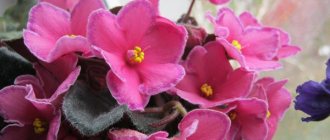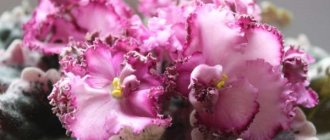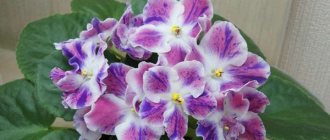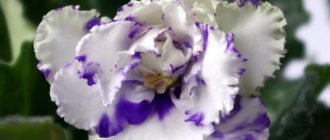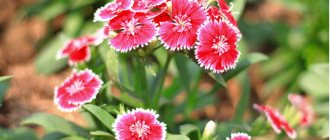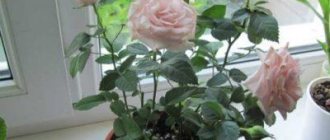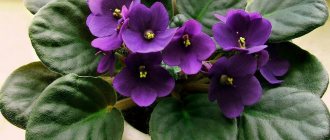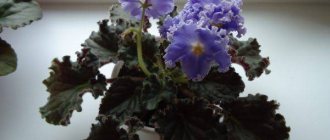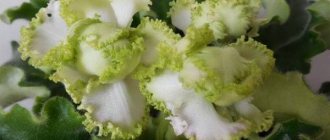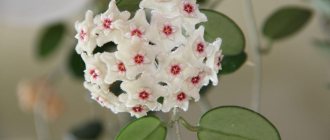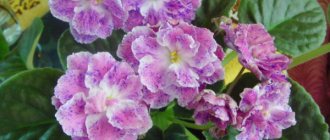Violet Shirl's Pip Squeak (S. Sanders), or Small Personality
Photo and description
The variety is sometimes mistakenly classified as micromini, but in fact it belongs to semi-miniatures.
The gel foliage is colored in a dark green shade, very openwork, curly. There is Tommy Low type variegation , that is, along the edge of the leaf. It is worth saying that variegation is more pronounced during the periods between flowerings.
When the rosette blooms, the round leaves will have a green color with almost no white inclusions. The older the rosette, the greater the amount of white color on the leaves.
The flower is pansy , simple or semi-double. The petals are light pink with plenty of purple fantasy touches.
The shade of the strokes is close to blue, but it can rather be called purple. It is worth noting that fantasy inclusions are prone to fading and within a few days after the flower has completely bloomed, they fade several tones.
It is impossible to ensure that all the flowers in a bouquet are painted in the same tones. There will always be a noticeable difference between buds that opened only yesterday and those that have been standing for quite some time. The diameter of the flower reaches 3.5 cm. For a small rosette, these flowers can be considered large.
The rosette has a strong tendency to thicken . This does not depend on the characteristics of care. All specimens of this variety behave this way.
To make room for the growth of peduncles and new leaves, it is worth removing young petioles inside the rosette . This phenomenon also increases under conditions of excessive lighting.
The description of the variety says that the rosette is semi-mini, but its diameter rarely exceeds 8-10 cm.
The variety produces constant flowering . It rarely produces a lush bouquet, but it practically cannot do without peduncles. Three or four flowers on a rosette are almost always present, regardless of the season.
He often goes into sports. Even those rosettes that produce the first flowers of a variety produce an increasing number of purple flowers or darken completely with age.
The variety is characterized by rapid growth. But the plant does not tolerate excessive moisture and wick watering . This even applies to the flowering period.
Sports appear as blue or purple colors. On average, about 30% of young children take up sports.
Goldfish. Genetic error or superanimal
Show description The interview was filmed at the Aqua Logo on Sokol supermarket https://www.aqualogo.ru/supermarkety_aqualogo#s. https://www.aqualogo.ru/. And this is what we talked about with the leading specialist of the Aqua Logo supermarket, Andrei Tikhonov: 0:33 When and how did the Golden Fish appear. 4:06 Gynogenesis in Goldens. 5:48 Do Goldens have males? 7:47 Goldfish Teeth. 9:39 Why they don’t have a stomach. 12:26 The myth about the indigestibility of protein foods. 13:28 How often should you feed Goldfish? 15:22 The myth of coldness. 20:02 Golden can survive completely without oxygen! 23:14 Why does such an unpretentious fish die so often among beginners? 30:00 Sizes of adult healthy fish. 30:47 Volume of an aquarium for a Goldfish. 35:54 Gold can change its color throughout its life. 41:55 How Lionheads can help in the fight against cancer. 44:42 Oranda is an ugliness or a work of art. 49:24 Are Goldens compatible with small fish, for example, neons?
Video taken from the channel: Green Art Moscow Aquariums
Caring for a plant at home
Violet prefers moderate lighting and does not tolerate excessive moisture. In such conditions, the center of the socket thickens.
Also, with wick watering, the diameter of the bush increases and fungal diseases, especially rust, can develop.
How to water and feed correctly?
Prefers only top watering. It is necessary to water the plant in a thin stream at the root, making your way under the dense growth of the rosette. When kept on a wick, the center of the rosette often rots and the plant dies.
The earthen ball should not be over-moistened ; moisture should be in moderation. For irrigation, use warm, settled or filtered water. Water along the very edge of the pot, trying not to get on the leaves and the growing point.
Violet does not tolerate overfeeding . If there is too much nitrogen, the center of the leaf blade will become excessively thick and fleshy.
As a result, the leaves will become excessively clumsy, the center of the rosette will become so clumsy and dense that it will lose all attractiveness.
If you give the plant more phosphorus than it needs, the leaf blades will turn an unpleasant yellow hue. If green veins appear on yellow leaves, this is a sign of nitrogen starvation.
Pale veins are a sign not only of underfeeding, but also of a lack of sufficient light.
Important! Instead of fertilizing, you can simply replant the violet into fresh substrate twice a year.
Lighting and temperature conditions
Saintpaulia variety Shirl's Pip Squeak requires a standard ten-hour light. It is acceptable to provide light for 12 hours, but in such a situation, excessive thickening of the center of the outlet is possible.
Comfortable temperature from +18 to +24°C. Do not allow drafts or sudden temperature changes. If it is cold, the violet will develop more slowly. But under such conditions, the flowering period becomes longer.
Reminder on the temperature of keeping violets.
Shirl's Pip Squeak violet prefers cooler conditions , in which case the risk of going into sports is minimized.
It is also very important to avoid hypothermia and sudden temperature changes .
Air humidity
The optimal option for this indicator is 55% . If it is too dry, then damp sphagnum moss is placed in the tray.
Soil composition
For this variety , poorer soil is selected than for ordinary violets . This will limit growth and avoid excessive formation of side shoots (stepchildren).
You can use store-bought mixtures or make your own. It is enough to take three parts of peat, half of a part of vermiculite and coniferous soil.
The presence of crushed coal and a small amount of sphagnum is also allowed.
Pruning and hygiene
Violet should be periodically treated against pests and diseases . It is also important to promptly remove dried and yellowed leaves.
If the first signs of the disease are observed on the leaf plate, then all plants on the windowsill should be immediately treated with a fungicide.
Rules for transplantation and rejuvenation
Violet periodically needs rejuvenation. To do this, the top part is cut off and placed in water or a weak rooting solution. The stem sprouts roots very quickly and after a few weeks the violet can be transplanted into fresh substrate.
The top can be rooted directly in water.
The variety can also be rejuvenated by growing a new plant from a leaf. Violet reproduces well, takes root quickly, and produces a large number of children . The leaf cuttings are rooted in moist sphagnum or substrate.
It is best to use a greenhouse or transparent plastic bag. In such conditions, the violet will develop much faster.
Advice! Do not forget about ventilation and removal of condensation.
Chimera violets
What it is?
Chimera plants are rare in nature. They usually occur:
- as a result of spontaneous mutations of somatic (non-reproductive) cells;
- in experiments with mutagens (colchicine, etc.);
- in regenerated plants (developed from a culture of isolated plant cells or tissues);
- due to mechanical damage;
- sometimes when propagated by seeds (sexual reproduction) due to instability of gene alleles.
In chimera plants, some organs consist of one or more cells or tissues carrying different genetic information . They can be located:
- mosaic;
- layers located one above the other;
- form large areas (sectors);
- form a mixture of longitudinal layers and sectors.
This provides extraordinary decorativeness to the plants.
Thus, each petal of a chimeric Saintpaulia is formed by two genetically different layers of cells , which determine its color:
- the main layer is responsible for the background pigmentation of the petals;
- auxiliary - for creating a clearly defined stripe or spot.
Such layering of tissues is also observed in the cross section of the petal.
Important! Typically, chimera appears only in plants that reproduce vegetatively (plant parts), since only in this case the characteristics persist for a long time.
In violets, the chimeric color is most fully conveyed by:
- cells located on the peduncle and bract;
- children obtained from a peduncle;
- stepsons.
This offspring will most likely repeat the maternal chimeric color.
All chimeric violets are divided into two types of color:
- Direct, when the main tone of the petals is dark and the central stripe is lighter;
- Reverse, with a prominent dark central stripe and a lighter base tone of the petals.
For a long time, chimera violets were not recognized as a variety, since they do not transmit their characteristics by cuttings.
To date, practical research has proven that instability during playback can be overcome in other ways. This solved the problem with registering new varieties.
Any method of obtaining such plants is very labor-intensive , which affects the price of chimera violets.
What does leaf chimera of violets mean?
Leaf chimeras are very rare ; there are only a few of them in the world. The leaf chimera differs from ordinary violet chimeras:
- ordinary flowers without a contrasting stripe in the center of the petals;
- unique pattern and color on the leaves;
- low chlorophyll content in leaf cells, as a result of which they develop to small sizes and form small rosettes.
Leaf chimera Rob's Lucky Penny.
Attention! Growing such a flower is not an easy task, but it is fascinating.
The best varieties
There are more than a hundred varieties of these extraordinary plants in the world. Some of them are classified as expensive and rare collectibles, others are industrial, which are grown in greenhouses for sale.
Often industrial varieties look less decorative, but are characterized by long and abundant flowering.
The most common chimeric varieties of violets include:
- Icy Hot;
- Princess K'Rei;
- Rob's Monreyshines;
- Tink;
- Victorian Parasol.
These varieties are grown in greenhouses for sale.
Sometimes the Winter Smiles variety (B. Makuni) is mistakenly classified as a chimera, but this is not so.
Information about the violet Winter Smiles is thoroughly analyzed here.
Reproduction methods
Chimera violets do not propagate by cuttings . There are other methods of reproduction for chimeras.
But what happens if you plant a chimera violet leaf? The planted cuttings form children that will bloom with ordinary monochromatic flowers.
There are three ways to obtain offspring from chimeric Saintpaulias:
- Rooting flower stalks. With this method, a flower-bearing arrow is used, on which a bract with a dormant bud is located. When the peduncle takes root, the bud awakens and forms a baby, to which the chimeric characteristics of the parent flower are transmitted;
Reproduction by peduncles. - Rooting with a separated tip . The apical part of the flower is cut off so as to preserve the growing point, then the separated part is planted in a container with an earthen mixture. The plant is cultivated in a greenhouse until it forms roots;
- Violation of the growth point . The growing point is disrupted by removing the tip or pinching the growing point. This stimulates the development of a large number of stepsons with new apical points. After separation and rooting, the stepsons give rise to new plants that retain the fancy coloring of the parent violet.
Important! Often, when propagated, chimeric Saintpaulias form sports - offspring that do not inherit all the varietal characteristics of the mother plant, but have their own characteristics. As in the case of chimeric violets, from sports you can get a new plant that repeats the parent color.
Features of flowering, growth and reproduction
Shirl's Pip Squeak variety grows easily and quickly at home . The leaves take root quickly, but they are immediately placed in the substrate.
They quickly take root and produce a large number of children . About a third of them go into sport, so all young plants should be grown before the first flowering.
A full-fledged plant can be grown in 2-4 months after planting the rosette in a separate container. The variety is easiest to propagate by leaf cuttings.
Propagation by leaf cuttings.
Prefers cool conditions ; in such conditions, the bright shade of the petals lasts longer.
One bud blooms for several weeks. The variety very rarely produces bouquet flowering , but there are always one or two peduncles on the rosette. Two or three days after blooming, the violet is very bright and beautiful, but then it becomes more faded.
Reviews
Sofia, Moscow. “I hold this variety for its tiny, no more than 6 cm, rosette, openwork painted leaves and huge flowers with ink stains. Despite the density, it is very beautiful and no variety will give such beautiful variegated foliage.”
Maria, Ryazan. “I put it on the wick, the center of the socket began to rot, although not even ten days had passed. I moved it to a greenhouse, but I plan to try growing it again using wick irrigation, since it’s inconvenient for me to add water to the root.”
Anna, Voronezh. “The violet is beautiful, but the center is very dense. Young leaves and flower stalks make their way to the top with great difficulty. I tore off some of the young leaves to allow the plant to grow and develop. But it blooms almost continuously.”
